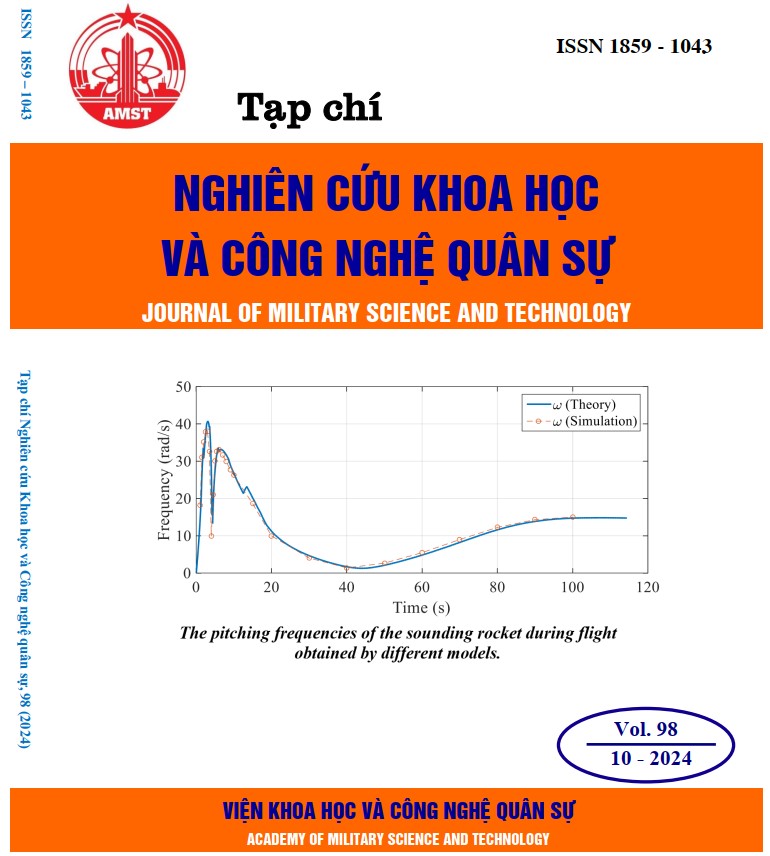Evaluation of the effectiveness of camouflage patterns using visual methods based on target detection time and distance surveys
561 viewsDOI:
https://doi.org/10.54939/1859-1043.j.mst.98.2024.116-123Keywords:
Camouflage effectiveness; Camouflage pattern; Visual evaluation; Target; Background; Observer.Abstract
Evaluation of camouflage effectiveness is the final step in research to create a set of camouflage products, for a scientifically based evaluation of the effectiveness of a set of camouflage products. In the article, the authors present a method for evaluating camouflage effectiveness experimentally based on the visual assessment of 10 observers in 2 stages: in the laboratory and in the field, from which the most suitable patterns are selected. The results after the survey determined 01 most suitable pattern for each background, with the shortest target detection range in mountainous terrain being L = 35 m (pattern R5), with the shortest target detection range in urban terrain being L = 30 m (pattern D1). The research results will be used to develop a complete camouflage effectiveness evaluation process.
References
[1]. J. R. Rao, “Introduction to camouflage and deception”, Defence research & development organisation, Ministry of Defence, New Delhi, (1999).
[2]. A. O. Ramsley, “Camouflage patterns – effects of size and color”, NXB PN, tr. 5-21, (1979). DOI: https://doi.org/10.21236/ADC020935
[3]. T. R. O'Neill, “Dual-tex 2: Field evaluation of dual-tex gradient pattern”, USMA, West Point, N.Y. City, pp. 1-13, (1977).
[4]. M. Friskovec et al, “Design and evaluation of a camouflage pattern for the Slovenian urban environment”, J. of Imaging Science and Technology, Vol. 020507, tr. 1-11, (2010). DOI: https://doi.org/10.2352/J.ImagingSci.Technol.2010.54.2.020507
[5]. Y. T. Prasetyo et al., “Assessing Indonesian Military Camouflage using Camouflage Similarity Index (CSI) Algorithm” MSIE 2020, doi: 10.1145/3396743.3396775. DOI: https://doi.org/10.1145/3396743.3396775
[6]. Nguyen Thu Cam et. al., “Giáo trình ngụy trang nghi trang trong phòng chống trinh sát quang điện tử”, People's Army Publishing House, (2023), (in Vietnamese).
[7]. T. T. Bao et al, “A method to evaluate camouflage effectiveness using computer-aided simulation”, Journal of Military Science and Technology, Vol. 90, (2023).
[8]. D. X. Doanh et al, “Multi-criteria evaluation method applied in camouflage”, Journal of Military Science and Technology, Special Issue of FEE National Conference, pg. 154-163, (2022).
[9]. M. Kalloniatis, C. Luu, “Visual acuity”, In: Kolb H, Fernandez E, Nelson R, editors. Webvision: The Organization of the Retina and Visual System, (2005).
[10]. Britannica, “Gestalt psychology”, T. Editors of Encyclopaedia, p. 756, (2020). ISBN 9781593394929, https://www.britannica.com/science/Gestalt-psychology.
[11]. Xu Chen, “Shape and size design, preparation and test evaluation of color unit in visible light and infrared camouflage”, Vol. 9, No. 4, p. https://www.sciencedirect.com/journal/heliyon, 8/2022. DOI: https://doi.org/10.1016/j.heliyon.2023.e14459
[12]. Q. Jia et al, “Intelligent design of gradual disruptive pattern painting and comparison of camouflage effectiveness”, Cluster Computing, Vol. 22, No. 4, pp. 9293–9301, (2019). DOI: https://doi.org/10.1007/s10586-018-2129-8
[13]. Y. J. Yan et al, “Fusion of dominant colour and spatial layout features for effective image retrieval of coloured logos and trademarks”, 2015 IEEE international conference on multimedia big data, pp. 306-311, (2015). DOI: https://doi.org/10.1109/BigMM.2015.43
[14]. S. Bi et al, “Optical classification of inland waters based on an improved Fuzzy C-Means method”, Optic Express, 27 (24/25), pp. 34838, (2019). DOI: https://doi.org/10.1364/OE.27.034838
[15]. Lin C. J. et al, “Evaluating camouflage design using eye movement data”, Applied Ergonomics, 45(3), 714–23, (2014). doi:10.1016/j.apergo.2013.09.012. DOI: https://doi.org/10.1016/j.apergo.2013.09.012







